The thumb is vital for high level hand function. The concept of the opposable thumb- the thumb that can meet the fingers for pinch and other high level function- has been said to separate man from at least some of our primate ‘relatives’. In the growing child, the thumb is key for exploring the world and, most notably at school age, for fine motor manipulation with pens, pencils, scissors, and other tools.
As a surgeon, our job is to assess thumb function and thumb alignment and, when necessary, offer intervention to assure each child can obtain maximal function. For some children, therapy can help with strength and help the child and family understand how to best function. For others, surgery can provide better alignment, rotation, or stability in an effort to allow the thumb ideal interaction with the fingers and with the world. Thumb stability is key to function but a lack of stability is not something that kids complain about (or know how to complain about). But pinch is affected and the surgeon should look for this issue as it is correctable with good results.
Thumb stability is most commonly compromised in two situations. First, the underdeveloped or hypoplastic thumb. I have previously blogged about the hypoplastic thumb HERE, among other blog posts. A typical hypoplastic thumb is small, has poor muscle and has an unstable joint. Surgery can address the instability and the lack of muscle support.
 |
| Hypoplastic thumb. Not the rotated position of the smaller thumb. |
And second, thumb polydactyly, or extra thumb, can be associated with instability. The most common scenario of instability in thumb polydactyly is after removal of the extra thumb. That is, the patient has surgery to remove the extra thumb and a lack of stability or a zig-zag deformity becomes a problem several years later.
Triphalangeal thumb, or a thumb with three bones rather than two, is often associated with polydactyly (extra thumb). Early surgery may be offered to remove the extra thumb and often the third bone in the primary thumb is initially watched to confirm whether or not that bone will cause problems. I have previously blogged about the problematic triphalangeal thumb HERE.
This is another example. This child had an extra thumb removed and there is deformity of the remaining thumb which is affecting function including pinch. There is a lack of pinch strength related to both a lack of stability and the deformity. In addition, the fact that the thumb has an extra joint (an extra area to bend) can change the way the thumb works. Adults have shared that this extra joint is not a good thing for function.
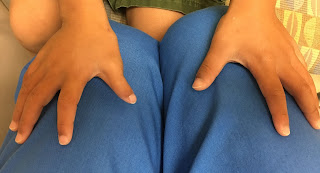 |
| Triphalangeal thumb. The thumb is small and crooked compared to the normal thumb. |
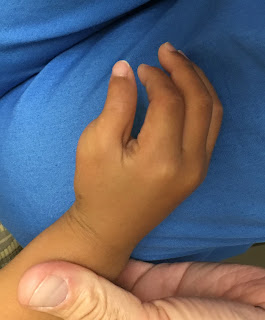 |
| Another view of the deformity of the triphalangeal thumb. |
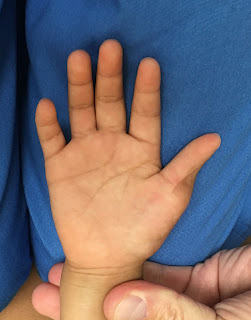 |
| Palm view of the triphalangeal thumb with visible scar from previous extra thumb excision. |
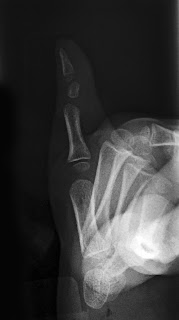 |
| Triphalangeal thumb with small middle bone (middle phalanx) |
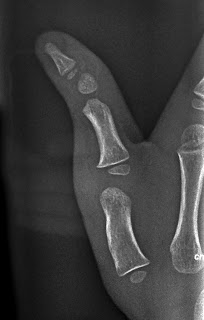 |
| Triphalangeal thumb with small middle bone (middle phalanx). The angulation of the thumb is clear. |
Thumb stability is key to function. This child will benefit from stability and correction of deformity.